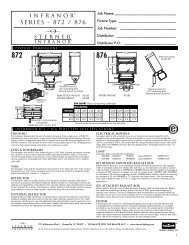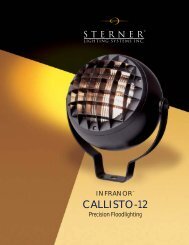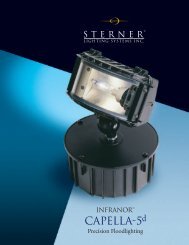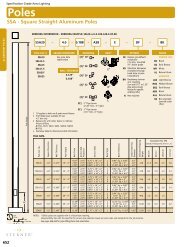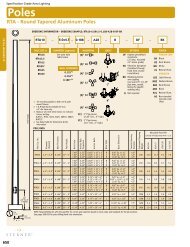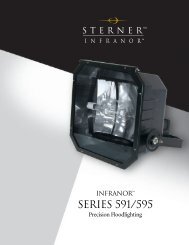EISA & Pulse Start MH Flyer - Hubbell Outdoor Lighting
EISA & Pulse Start MH Flyer - Hubbell Outdoor Lighting
EISA & Pulse Start MH Flyer - Hubbell Outdoor Lighting
Create successful ePaper yourself
Turn your PDF publications into a flip-book with our unique Google optimized e-Paper software.
<strong>Hubbell</strong> <strong>Lighting</strong><br />
<strong>Outdoor</strong> & Industrial<br />
<strong>Pulse</strong> <strong>Start</strong> <strong>MH</strong><br />
Our Commitment<br />
& <strong>EISA</strong> At a Glance<br />
Energy Independence and Security Act of 2007<br />
When<br />
What does <strong>EISA</strong> mean to us?<br />
Energy Advantange of <strong>Pulse</strong> <strong>Start</strong> technology<br />
<strong>EISA</strong> is setting efficiency standards for metal halide (<strong>MH</strong>) luminaires, from<br />
150w to 500w, produced on or after January 1, 2009.<br />
<strong>EISA</strong> Requirements<br />
We are adding <strong>EISA</strong>-compliant pulse start wattages to all applicable<br />
families of products, if they do not already exist. All new<br />
wattages will be available by the end of the year. We will continue<br />
to update our brand websites with the latest energy-saving pulse<br />
start technology products, marked with our “Powered by <strong>Pulse</strong><br />
<strong>Start</strong>” trademarked logo.<br />
<strong>EISA</strong> legislation sets the following efficiency standards:<br />
• 88% minimum efficiency for a pulse start ballast<br />
• 94% minimum efficiency for a magnetic probe start ballast<br />
For a non-pulse start electronic ballast—<br />
• 92% minimum ballast efficiency for wattages > 250 watts<br />
• 90% minimum ballast efficiency for wattages < 250 watts<br />
<strong>Pulse</strong> <strong>Start</strong> technology provides an ENERGY ADVANTAGE<br />
• You can use lower wattage pulse start fixtures for equivalent lumen output of higher<br />
wattage traditional probe start fixtures:<br />
• 350w or 320w pulse start fixtures can replace standard 400w probe start fixtures<br />
• 150w pulse start fixtures can replace standard 175w probe start fixtures<br />
Exceptions<br />
<strong>EISA</strong> allows for exemption of 150W wet location fixtures from the efficiency standard. Therefore we will<br />
discontinue production of wet location 175W probe start fixtures by the end of the year, and will replace with<br />
150W pulse start fixtures for energy savings, with an increase in maintained lumens in most cases!!<br />
What Happens to Probe-<strong>Start</strong><br />
Manufacturers and Distributors may legally sell probe start <strong>MH</strong> luminaires (produced before Jan 1, 2009) for<br />
as long as their inventories last. Ballast manufacturers may continue to produce probe start ballasts, so field<br />
replacement ballast and lamp business will not be impacted.
Probe <strong>Start</strong> vs. <strong>Pulse</strong> <strong>Start</strong> Comparison<br />
Probe <strong>Start</strong><br />
<strong>EISA</strong> Compliant <strong>Pulse</strong> <strong>Start</strong><br />
Watts Mean Lumens * Life Watts Watts Mean Lumens * Life Watts<br />
175 9,100 10,000 210<br />
150 10,500 15,000 185<br />
175 11,200 15,000 198<br />
250 13,500 10,000 295<br />
200 16,800 15,000 277<br />
250 16,625 15,000 291<br />
320 21,000 20,000 361<br />
400 24,000 20,000 458 350 25,200 20,000 397<br />
400 29,820 20,000 452<br />
* Based on Phillips lamp data, except 200W <strong>Pulse</strong> <strong>Start</strong>, which is based on Venture lamp data<br />
<strong>EISA</strong> Labeling Example<br />
The <strong>EISA</strong> legislation also defines labeling requirements that allow field identification of <strong>EISA</strong>-compliant <strong>MH</strong><br />
fixtures. Both the ballast and the fixture packaging shall be marked with a capital letter E printed within a<br />
circle, as depicted below.<br />
Labeling example<br />
<strong>EISA</strong> Legislation<br />
Ballast label<br />
Energy Independence & Security Act of 2007<br />
Public Law 110–140—Dec. 19, 2007<br />
Fixture packaging<br />
Sec. 324. Metal Halide Lamp Fixtures<br />
Metal halide lamp fixtures, from 150w to 500w, produced on or after Jan 1, 2009,<br />
shall contain a ballast with the following minimum efficiency level—<br />
(i) 88% for <strong>Pulse</strong> <strong>Start</strong> <strong>MH</strong> ballasts<br />
(ii) 94% for Magnetic Probe <strong>Start</strong> <strong>MH</strong> ballasts<br />
(iii) For Non-<strong>Pulse</strong> <strong>Start</strong> electronic ballasts—<br />
(I) 92% for > 250w<br />
(II) 90% for < 250w<br />
EXCLUSIONS.—The efficiency standards do not apply to—<br />
(i) fixtures with regulated lag ballasts;<br />
(ii) fixtures that use electronic ballasts that operate at 480 volts; or<br />
(iii) fixtures that— ‘‘(I) are rated only for 150 watt lamps; (II) are rated<br />
for use in wet locations per NEC 202, section 410.4 CA); and (III) contain a<br />
ballast that is rated to operate at ambient air temperatures above 50°C,<br />
as specified by UL 1029–2001.<br />
LABELING.—The rules shall provide that any metal halide lamp fixture<br />
manufactured on or after January 1, 2009, shall contain a capital letter<br />
‘E’ printed within a circle on the packaging of the fixture, and on the ballast<br />
contained in the fixture.<br />
Visit us on-line for latest energy saving <strong>Pulse</strong> <strong>Start</strong> products and sales tools:<br />
www.hubbellindustrial.com • www.hubbelloutdoor.com • www.spaulding-ltg.com<br />
www.sternerlighting.com • www.devine-ltg.com



